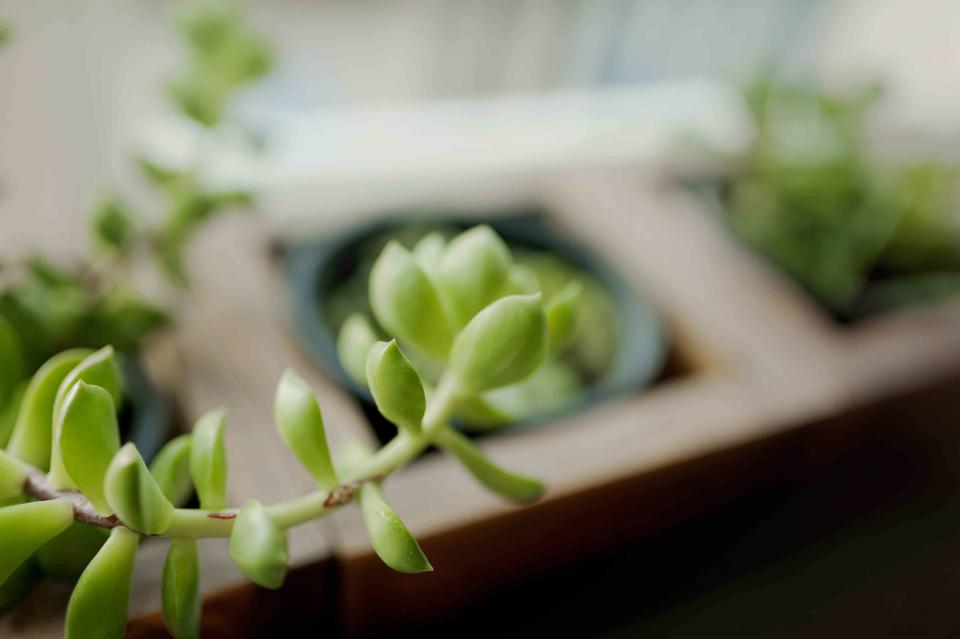Why Is My Succulent Growing Tall?
What to know about leggy succulents and how to fix it

devonanne / Getty Images
Many succulents, like echeveria, sedum, and hens and chicks, are known for their cute, compact size and floral appearance. So when your succulent starts to grow tall and lanky and loses that trademark look that it had when you brought it home, it can be alarming, to say the least. Luckily, it’s a common problem, and there’s a very simple explanation for why your succulent is growing this way (and a simple solution, too). Here’s what you need to know about why your succulent is growing tall and what you can do to fix it.
Text Link:How to Revive a Succulent
Tall Growth Is Etiolated
When succulents that are supposed to have a compact growth habit grow tall and lanky, it’s called etiolated growth, or getting "leggy." A leggy succulent has a long stem or long branches with leaves that are spaced far apart from each other. Sometimes, the leaves will also be smaller than usual and change color, usually becoming less vibrant. Etiolation can happen to many different kinds of succulents, but it is particularly obvious with rosette-shaped succulents, like echeveria or sempervivum, that are known and collected for their compact shape.
What Causes Etiolated Growth?
Succulents that aren’t getting enough light can become leggy and experience etiolated growth. Often, you’ll notice that your plant is literally reaching toward the nearest light source in an effort to find the light that it needs. Etiolated growth is a sign that your plant is not growing under the right conditions, and a change needs to be made. Remember that succulents thrive with lots of sunlight, particularly succulents native to desert conditions. While your succulent may look nice sitting on your coffee table or on your dresser next to your bed, the reality is that it should be sitting on a bright, sunny windowsill where it gets at least five to six hours of direct sunlight every day. If lack of sunlight is an issue, a grow light can provide the proper amount of light needed. Leave the darker areas of your home for low-light plants that will thrive in those conditions like ZZ plants, pothos, and snake plants.
While leggy growth can be triggered by light depravation, it can also result from warm temperatures and moisture.
How to Fix a Leggy Succulent
Unfortunately, leggy growth can’t be reversed. You can make changes to your plant’s environment (like moving it closer to a light source) to ensure that future growth is healthy, but there’s no way to fix the damage that has already been done. Luckily, as long as you actively make changes to provide your succulent with the conditions that it needs to thrive moving forward, etiolated growth is mostly an aesthetic issue. However, if you're increasing the amount of sunlight, make sure to do it slowly--about 30 minutes per day, adding more time gradually--to avoid the leaves becoming sunburned.
That being said, if your succulent’s leggy appearance is something you just can’t live with there is something you can do: chop it and propagate it. This option often feels scary to those who aren’t experienced with propagating succulents, but it’s very easy to do. Plus, when you’re finished, you’ll be left with a healthy-looking succulent and (hopefully) several baby succulents too.
How to Propagate a Leggy Succulent
Propagating a leggy succulent is easy and can be done in just a few steps. The best part about propagating a leggy succulent is that nearly every part of the plant can be used to grow new plants. This means that your single leggy succulent may transform into several plants by the time you are done.
Using a pair of sharp, clean pruning shears or scissors, cut the top part of your succulent off where the leggy growth begins. Leave the 1-2 inches of the bottom portion of the succulent in the pot with 2-3 leaves for best results. Sometimes, the base may produce offshoots without leaves left on it. Move the base plant to a bright, sunny location like a windowsill. Take the top stem cutting, trim to the desired height, leaving at least 1-2 inches of stem, then remove the leaves along the stem by gently twisting them until they pop off. Leave the top few leaves on the stem cutting. Take the leaves that you removed and lay them on top of a well-draining soil mix in a tray or small pot. Place the tray or pot of leaves in a bright location. Then, fill a small pot with moist, well-draining succulent soil and plant the top stem cutting in the soil, pushing the bare stem down into the soil until the remaining leaves are resting just above the surface. Place the potted stem cutting in a similarly bright location. It should begin developing roots within a few days to a few weeks. The base plant should begin sending out offshoots within 2-3 weeks.
You will now have three different propagations going from your plant—the bottom stem, the leaves, and the top stem. The top stem cutting will be the closest in size to your original plant by the time it roots, while the leaves and bottom stem will grow small succulent pups that will grow and mature over time.
To care for your propagations, the most important thing is to provide them with enough light. Also, be sure not to overwater them. The bottom stem can be watered once the soil is completely dry, since it already has established roots, while you should wait to water the leaves and the top cutting until new roots have begun to grow.
Read Next:How Much Light Do Succulents Need?

